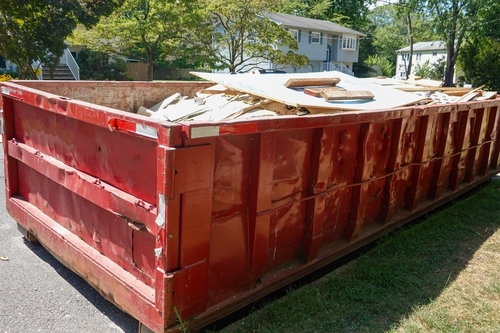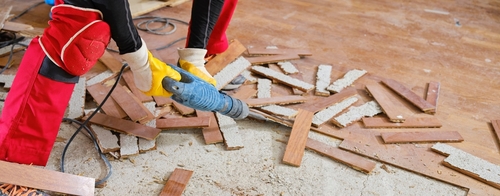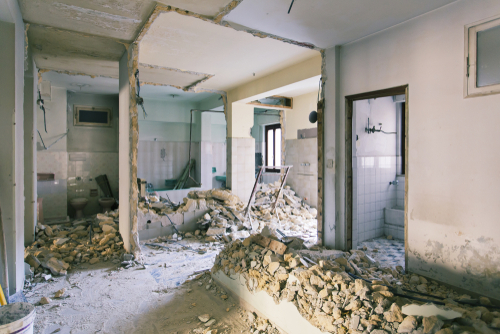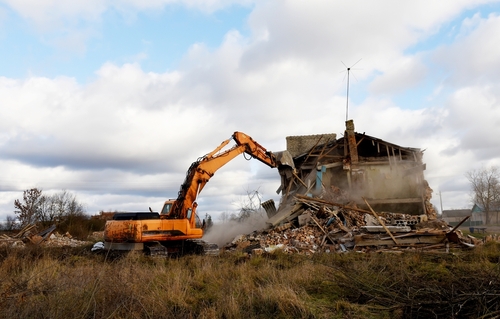June 11, 2024 - Benjamin Ehinger
Tear Down a House Yourself: A Step-by-Step Demolition Guide
CALL NOW 844-762-8449
Demolishing a house is a significant undertaking that demands careful planning and an understanding of the process. For homeowners considering taking down a house by themselves, it’s important to be aware of the steps involved and the complexity of the task at hand. This includes everything from obtaining the necessary permits and disconnecting utilities to choosing the right method of demolition and ensuring the safety of everyone involved. It’s crucial to approach this process with caution and thorough preparation to avoid potential hazards and ensure compliance with local regulations.
Renting multiple dumpsters from Waste Removal USA, or similar services, will likely be a part of your demolition project. The amount of debris generated from a house demolition is substantial, and proper waste management is not only a logistical concern but an environmental one as well. By renting the appropriate dumpsters, you can ensure the debris is handled responsibly and in a manner that aligns with local disposal regulations. Additionally, a well-thought-out demolition can provide opportunities to salvage valuable materials, reducing waste and possibly offsetting some costs.
 When you’re demolishing a house, choosing the right type and number of dumpsters is crucial for an efficient cleanup. Each phase of demolition may require a different dumpster size, tailored to the type of waste being disposed of.
When you’re demolishing a house, choosing the right type and number of dumpsters is crucial for an efficient cleanup. Each phase of demolition may require a different dumpster size, tailored to the type of waste being disposed of.
 When you decide to tear down a house yourself, the demolition method you choose can affect the efficiency, safety, and cost of your project.
When you decide to tear down a house yourself, the demolition method you choose can affect the efficiency, safety, and cost of your project.
 Prioritizing safety is critical when demolishing a house. You need the right gear and strict adherence to structural safety protocols.
Prioritizing safety is critical when demolishing a house. You need the right gear and strict adherence to structural safety protocols.
 When you decide to tear down a house yourself, it is important to consider the effects it will have on the people living around the demolition site. Your actions can significantly affect your neighbors’ daily life and the general peacefulness of the community.
When you decide to tear down a house yourself, it is important to consider the effects it will have on the people living around the demolition site. Your actions can significantly affect your neighbors’ daily life and the general peacefulness of the community.
Key Takeaways
- Demolition requires careful planning, including obtaining permits and adhering to safety regulations.
- Expect to rent multiple dumpsters for efficient debris management and disposal.
- Select a demolition method that suits the structure and complies with local ordinances.
Understanding Demolition Requirements
In the realm of home demolition, familiarizing yourself with the necessary permits and recognizing the presence of hazardous materials is crucial for a safe and lawful teardown. This is not a mere formality but an integral part of the process that ensures personal and environmental safety.Demolition Permits and Legalities
Before you begin to tear down a house, you need to secure the correct demolition permits. Although the requirements can vary, generally you will need to submit an application to your local government and may need to provide site plans, as well as explain the methods and scope of your demolition project.- How to Obtain a Demolition Permit:
- Check with your local building department or municipal office.
- Fill out the necessary application forms.
- Submit any required documentation, like site plans.
- Pay the applicable fees, which can differ based on location and project size.
Identifying Hazardous Materials
Before demolition, identify any hazardous materials, especially asbestos, which was commonly used in older homes and can be a health risk if disturbed. If you suspect your home contains asbestos or other dangerous substances, it’s essential to have a professional assessment.- Steps to Identify and Manage Hazardous Materials:
- Hire a certified inspector to conduct an assessment.
- Do not attempt to remove hazardous materials without professional help.
- Ensure that removal and disposal of hazardous materials adhere to local regulations.
Preparing for Demolition
Before you begin the physical task of tearing down a house, it’s crucial to have a clear plan and budget to guide the demolition process. Careful planning can help you avoid unexpected expenses and ensure that the project is completed safely and efficiently.Planning and Budgeting
When tearing down your home, the first step is to understand the cost of house demolition which varies widely depending on the size of your home, the materials involved, the disposal fees, and your location. Typically, costs can range from a few thousand dollars to over $20,000. Itemize potential expenses to get a clear financial picture. Next, research and select a contractor if you decide professional help is needed. Seek multiple quotes and check references to find a reliable partner for this critical stage. Remember, the cheapest option isn’t always the best. Consider the demolition process itself; you’ll need to secure necessary permits, disconnect utilities, and inform neighbors about the project. Demolition involves numerous steps, including the removal of hazardous materials, disassembling the structure, and waste disposal. Do not forget labor costs if you hire a crew. Labor often represents a significant portion of the overall expenses, and understanding these costs upfront will help you budget correctly. If you’re doing some of the work yourself, price out any tools or equipment rentals you need for the project. Remember to include a contingency fund, typically 10-15% of the total budget, for unexpected issues that may arise during demolition. Being financially prepared will give you peace of mind throughout the process.Dumpster Rentals You Will Likely Need
 When you’re demolishing a house, choosing the right type and number of dumpsters is crucial for an efficient cleanup. Each phase of demolition may require a different dumpster size, tailored to the type of waste being disposed of.
When you’re demolishing a house, choosing the right type and number of dumpsters is crucial for an efficient cleanup. Each phase of demolition may require a different dumpster size, tailored to the type of waste being disposed of.
Concrete Dumpster Rental
For the concrete components of your house, like the foundation and any pathways, you’ll need a concrete dumpster rental. Concrete is heavy and dense, so dumpsters designated for concrete are typically smaller to avoid overweight fees, yet sturdy enough to handle the load. Expect 10-yard dumpsters to be suitable for this part of your demolition waste. Keep in mind that the cost here will also incorporate potential recycling fees since concrete can often be recycled.Roofing Dumpster Rental
Shingle disposal when tearing down your roof dictates the need for a roofing dumpster rental. Roofing materials can be bulky and require a dumpster that accommodates volume without exceeding weight limits. Commonly, a 20-yard dumpster is adequate for roofing disposal. Labor costs for roof demolition can be substantial, so efficient waste management is essential.Yard Waste Dumpster Rental
Your demolition will likely generate a significant amount of green waste, such as trees, shrubs, and sod. Choose a yard waste dumpster rental which typically come in 10, 15, 20 and 30-yard sizes. Yard waste dumpsters should not be filled with other demolition debris to avoid contamination. This is a cost-effective solution, as pure yard waste can be processed differently and often more cheaply than mixed demolition debris.Multiple 40-Yard Dumpster Rental
For large-scale house demolitions, multiple 40-yard dumpster rentals are often required. These dumpsters are the largest available and can accommodate a broad range of debris, such as drywall, lumber, fixtures, and other construction materials. Given the hefty nature of labor costs and the extensive debris generated during the demolition process, multiple dumpsters may be necessary to manage the waste efficiently without hindering the workflow. Selecting the correct dumpsters will streamline your demolition process and could potentially reduce overall contractor and labor costs. Remember, you may need licenses to place a dumpster on public property. Always consult with a professional if you’re unsure about the specifics.Disconnecting Utilities and Services
Before you begin the physical work of tearing down your home, a crucial step is ensuring all utilities are properly disconnected. It’s not only a safety concern but a necessary legal requirement.Working with Utility Companies
- Electricity and Gas: You must contact your electricity and gas providers at least a few weeks before demolition. Request a service termination on your specified dates. These companies will send out professionals to disconnect main lines.
- Water and Sewage: Similarly, reach out to your local water and sewage company. They will need to cap off the respective lines to prevent leaks and other hazards after the house is demolished.
- Documentation: Keep a record of all disconnection notices and confirmations. This proof may be required by the demolition permitting office.
Securing the Premises
- Fencing: Erect a temporary fence around the property to ensure the site is secure post utilities disconnection. This is also important to keep unauthorized persons from entering the hazardous area.
- Signage: Post clear signs around the property indicating that demolition is in progress and that utilities have been disconnected. This serves both a legal and safety purpose.
- Physical Barriers: Besides fencing, employ sturdy barriers such as concrete barricades around major points like gas lines and utility poles to avert any accidental damages.
Choosing the Right Demolition Method
 When you decide to tear down a house yourself, the demolition method you choose can affect the efficiency, safety, and cost of your project.
When you decide to tear down a house yourself, the demolition method you choose can affect the efficiency, safety, and cost of your project.
Mechanical versus Manual Demolition
Mechanical Demolition: involves heavy machinery such as bulldozers, excavators, or cranes. It is faster and suited for complete demolition of buildings. Before choosing this method, check local regulations regarding machinery usage on residential properties. Also, consider the proximity of other structures and the potential for collateral damage. Manual Demolition :is more labor-intensive, as it relies on hand tools like sledgehammers and pry bars. It allows for more precision, which is particularly useful for a selective or partial demolition, where you only want to remove certain sections of a house.Partial versus Complete Demolition
Partial Demolition: Select this when certain parts of the house are to be preserved or renovated. This approach requires careful planning to ensure the stability of the remaining structure. Complete Demolition: is necessary when the entire house must come down. This method is straightforward but requires thorough site preparation, such as disconnecting utilities and ensuring that debris does not affect neighboring properties. Remember to always prioritize your safety and to check local regulations before proceeding with your chosen demolition method.Home Evaluation and Salvaging
Before beginning the demolition of your home, it’s critical to conduct a thorough inspection and identify materials that can be salvaged. This not only ensures a safer demolition process but also maximizes the recovery of valuable materials.Performing a Home Inspection
Your first step in the demolition process is to inspect the structure of your home. This ensures that you’re aware of any hazardous materials that could pose health risks, such as asbestos or lead. It’s imperative to engage a certified inspector to identify these materials. A comprehensive inspection will focus on the stability of the structure, electrical systems, plumbing, and other critical components.- Exterior Check: Look for signs of structural damage, such as cracks in the foundation or roof damage.
- Interior Review: Inspect the condition of walls, floorings, and support beams.
- Hazard Identification: Recognize any hazardous materials that require professional removal.
Identifying Salvageable Materials
Once you’ve ensured the house is free from hazardous materials and have understood its overall condition, focus on salvageable items. These are materials you can recycle, sell, or donate, which may help offset demolition costs while reducing waste.- Metals: Copper wiring, steel, and aluminum features can be highly valuable.
- Fixtures: Doors, light fixtures, and plumbing parts.
- Architectural Elements: Mantels, hardwood floors, and bricks.
Demolition Safety Measures
 Prioritizing safety is critical when demolishing a house. You need the right gear and strict adherence to structural safety protocols.
Prioritizing safety is critical when demolishing a house. You need the right gear and strict adherence to structural safety protocols.
Personal Protective Equipment
When preparing for demolition, your first step is to equip yourself with the appropriate Personal Protective Equipment (PPE). This includes:- Hard Hat: Protects your head from falling debris
- Safety Glasses or Goggles: Shields your eyes from dust and flying particles
- Hearing Protection: Earplugs or earmuffs to prevent hearing damage from loud noises
- Heavy-Duty Gloves: To guard your hands against cuts, scrapes, and punctures
- Respirator or Dust Mask: Keeps you from inhaling hazardous materials like asbestos or silica
- Steel-Toed Boots: Ensures foot protection from falling objects and punctures
Structural Safety Protocols
Next, focus on Structural Safety Protocols to prevent accidents during the teardown:- Inspect the Structure: Check the building for stability before any work begins.
- Shut Off Utilities: Ensure all electricity, gas, and water are disconnected to avoid accidents.
- Asbestos Evaluation: Have a professional assess the presence of asbestos—it’s vital to address this risk before starting demolition.
- Use Correct Tools: Equip yourself with the right tools for the job to minimize risk and ensure efficiency.
- Emergency Plan: Have a clear plan in case of emergencies, including a first aid kit and easy access to emergency services.
Executing the Demolition
Successful demolition requires a blend of robust machinery operations and meticulous manual techniques. Each plays a pivotal role in dismantling a structure safely and efficiently.Operating Demolition Machinery
When using demolition machinery, it’s imperative that you operate with precision and caution. The demolition crew should be trained and certified to handle such equipment, which typically includes excavators, bulldozers, and cranes. Here’s a brief guide on machinery operation:- Inspection: Before starting, inspect all machinery to ensure they are in working condition.
- Safety Gear: Wear appropriate safety gear—hard hats, gloves, and protective eyewear are a must.
- Operation:
- Excavators: Used for tearing down structures; practice makes perfect in handling the hydraulic arm with control.
- Bulldozers: Great for clearing debris post-demolition; ensure the area is clear of all personnel before operation.
Manual Demolition Techniques
Manual demolition is about detail and labor intensity, suitable for interior stripping or where machinery can’t reach. Consider the following techniques:- Stripping Fixtures: Start by removing doors, windows, and fixtures to prevent them from being damaged.
- Hand Tools: Employ crowbars, sledgehammers, and hammers for removing smaller sections of the house, working from top to bottom to maintain safety.
Handling and Disposal of Debris
After demolishing a house, properly managing the remaining debris is crucial for safety and legal compliance. Identifying materials for recycling and coordinating with professional services are key steps.Sorting Demolition Waste
Begin by sorting the debris into categories for efficient disposal. You should separate materials such as:- Metals: These can often be recycled.
- Wood: Reusable or recyclable, depending on condition.
- Concrete: Can be crushed and repurposed.
- Hazardous waste: Requires special handling and should never be mixed with general waste.
Professional Debris Removal Services
Once you’ve sorted the waste, consider hiring professional debris removal services. They offer:- Convenience: Save time and effort with a professional team.
- Safety: Experts know how to handle dangerous materials properly.
- Compliance: Ensuring all local regulations for disposal and recycling are met.
Impact on the Community
 When you decide to tear down a house yourself, it is important to consider the effects it will have on the people living around the demolition site. Your actions can significantly affect your neighbors’ daily life and the general peacefulness of the community.
When you decide to tear down a house yourself, it is important to consider the effects it will have on the people living around the demolition site. Your actions can significantly affect your neighbors’ daily life and the general peacefulness of the community.
Informing Neighbors
Before you begin the demolition process, it’s essential to inform your neighbors of your plans. This is not only courteous, but it can also help in managing their expectations and allaying any concerns they might have. Provide a clear timeline of the demolition activities, and share the steps you’ll take to ensure safety and compliance with local regulations. Here’s how you might approach this:- Draft a notification letter explaining the project scope.
- Designate a point of contact for any questions or issues that might arise.
- Plan a meeting or a casual chat to discuss the project in person, if possible.
Minimizing Disruption
To minimize the disruption to the community, strategic planning is vital. Noise, dust, and traffic caused by the teardown can lead to discomfort and even health issues. Here are specific steps you can take:- Schedule demolition during permitted hours to avoid unnecessary disturbance.
- Use protective measures, such as dust screens and noise barriers, to shield your neighbors from debris and loud sounds.
- Make sure that traffic flow is not hindered by trucks and equipment coming to and from your property. Consider arranging for off-site parking if necessary.
- Investigate the use of less invasive demolition techniques that reduce overall disruption.
Post-Demolition Steps
Once the physical demolition of your house is complete, your focus should shift to preparing the cleared site for what comes next and ensuring all required procedures have been followed.Clearing the Lot for Future Use
After demolition, it is essential to properly clear the lot to make it suitable for future use, whether that be for constructing a new property or another purpose. Begin with the removal of all demolition debris, separating materials that can be recycled or sold. Next, attend to the following tasks:- Soil testing: Conduct soil tests to determine if the lot is safe for future construction.
- Grading and leveling: Grade the land properly to prevent drainage issues, which can be a key consideration for real estate development.
- Environmental cleanup: Address any remaining environmental hazards like asbestos or oil tanks if not done prior.
- Property survey: Have the property surveyed to mark boundaries clearly.
Final Inspections and Approvals
Getting the necessary final inspections and approvals is a crucial step that ensures your demolition work adheres to local regulations. Keep in mind that:- Building department sign-off: Your local building department must sign off on the demolition job. This often requires a final inspection.
- Notify your mortgage lender: If there’s an existing mortgage on the property, inform your mortgage lender of the demolition as it can impact the terms of your loan.
- Documentation: Keep a record of all permits and approvals in case they are requested in future real estate transactions or by local authorities.
Frequently Asked Questions
Tackling the task of house demolition involves understanding the necessary preparation steps, obtaining permits, considering costs, and acknowledging the time investment. Be aware of legal ramifications and financial implications intrinsic to the process.What are the necessary steps to prepare for a house demolition?
To prepare for a house demolition, you’ll need to start with clearing the house of furniture, personal items, and fixtures. Utilities such as water, gas, and electricity must be safely disconnected. Subsequently, you’ll need to dismantle interior elements like drywall and flooring, proceeding cautiously to expose the structure beneath.What permits are required for residential demolition?
You’re generally required to obtain a demolition permit from your local government before starting the demolition work. This ensures your project adheres to local regulations and safety standards. Check with your municipality for specific requirements, as they can vary widely by location.What are cost-effective strategies for demolishing a house?
To keep costs down during a demolition, consider salvaging and selling materials or doing portions of the work yourself. Hiring a professional for more complex tasks while performing simpler tasks can also be a balanced approach to manage expenses effectively.How much time is typically needed to properly deconstruct a house?
The time needed for deconstruction can range significantly depending on the size of the house and the complexity of the job. Typically, a full house demolition can take anywhere from a few days to several weeks. Planning and executing each phase methodically is crucial to efficiency.Can you legally demolish your own home without professional assistance?
While you can legally demolish your own home, it’s essential to satisfy all regulatory requirements and possess the right tools and skills for the job. If unsure about certain aspects, consulting professionals is recommended for safety and compliance with local codes.What financial considerations should be addressed before house demolition?
Before beginning the demolition process, it’s crucial to budget for permit fees, equipment rental or purchase, labor costs if hiring professionals, and waste disposal. Additionally, account for the potential resale of materials and unforeseen expenses that may arise during the demolition.RECENT BLOGS
Our Reviews
Glenda Lanier Prowell
1721758635
I have ordered an 11 yard dumpster to be delivered to my house.Lonier was extremely helpful and answered all my questions. The rate was very reasonable.
Cedric Smikle
1721660395
Amber was extremely professional and courteous. She answered all of my questions and even some that I didn’t know I needed to ask.
Cait Kaider
1721243051
I highly recommend Waste Removal USA for their responsiveness and how the staff work hard to provide exceptional customer service. They have done well by us and our clients. Thank you!
Easom Family
1721223306
Louiner Pierre-Louis Is awesome! Did a great job. Will definitely be using this same company for all my dumpster needs because of his awesome customer service! Thank you!!!
tabitha Vazquez
1720539988
Wonderful and fast customer service!
LATEST BLOGS






